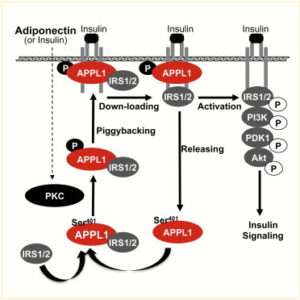The adaptor protein APPL1 (Adaptor protein-containing an NH2-terminal Bin/Amphiphysin/Rvs (BAR) domain, a central Pleckstrin homology (PH) domain, Phosphotyrosine-binding (PTB) domain, and Leucine zipper motif), is an insulin-sensitizing molecule in multiple insulin-responsive tissues. Genetic disruption of APPL1 causes insulin resistance and defective glucose-stimulated insulin secretion, leading to glucose intolerance in mice. In contrast, transgenic overexpression of APPL1 prevents obesity-induced deleterious effects on glucose homeostasis and endothelial and cardiac functions. Hepatic overexpression of APPL1 improves hyperglycemia, glucose intolerance and insulin sensitivity in db/db diabetic mice, whereas hepatic silencing of APPL1 causes insulin resistance and hyperglycemia in lean mice. Similarly, in skeletal muscle, overexpression of APPL1 enhances glycogen storage and insulin-stimulated glucose uptake as a consequence of activation of the PI3K-Akt signaling pathway, whereas knockdown of APPL1 expression exerts the opposite effects. In pancreatic β-cells, APPL1 promotes glucose-stimulated insulin secretion by upregulating expression of soluble N-ethylmaleimide-sensitive factor attachment protein receptor proteins in an Akt dependent manner. At the molecular level, the interaction between APPL1 and Akt prevents Akt from binding to the pseudokinase tribble-3 (TRB3), thereby promoting Akt to the plasma membrane for further activation. Our more recent study found that tumor necrosis factor receptor associated factor 6-mediated ubiquitination of APPL1 is indispensable to the membrane targeting of Akt and its insulin-sensitizing actions. Furthermore, APPL1 potentiates the insulin-sensitizing effects of adiponectin on promotion of glucose uptake by direct interaction with the two adiponectin receptors.
Also known as DCC-interacting Protein 13-alpha.

Relevant recent publications:
1. Signaling mechanisms underlying the insulin-sensitizing effects of adiponectin. Cheng KK, Lam KS, Wang B, Xu A. Best Pract Res Clin Endocrinol Metab. 2014 28(1):3-13
For more information and purchasing details see below.


